
Cockroach Control in Cape Canaveral, FL
Cape Canaveral, known for its historic space launches and pristine beaches, is a beautiful coastal city in Florida. However, even this Space Coast gem isn't immune to the persistent problem of cockroach infestations. The warm, humid climate of Cape Canaveral provides an ideal environment for these resilient pests to thrive, making cockroach control a constant challenge for local residents.
If you're dealing with a cockroach problem in your Cape Canaveral home, you're not alone. These unwanted guests can quickly turn your space-age dreams into a nightmarish reality. But don't worry – there's hope! With the right approach and professional help, you can reclaim your home from these pesky invaders. For expert assistance, you can reach out to All U Need Pest Control at (888) 239-Bugs (888-239-2847). Their team of experienced professionals understands the unique challenges posed by Cape Canaveral's coastal environment and can provide tailored solutions to keep your home cockroach-free.
In this comprehensive guide, we'll explore effective methods for cockroach control specific to Cape Canaveral, from DIY techniques to professional treatments. We'll also delve into prevention strategies that take into account the city's unique climate and geography. So, whether you live near the Kennedy Space Center or closer to the beach, you'll find valuable information to help you launch a successful offensive against these persistent pests.
Pest Control Services in Cape Canaveral, FL

How to Get Rid of Cockroaches in Cape Canaveral, FL
Dealing with cockroaches in Cape Canaveral requires a multi-faceted approach. The city’s proximity to the ocean and its warm, humid climate create ideal conditions for cockroach populations to flourish. Here’s how you can effectively combat these resilient pests:
Cockroach Baiting
Baiting is an effective method for controlling cockroaches in Cape Canaveral homes. This technique involves strategically placing pesticide-infused bait stations in areas where cockroaches are commonly found. In our coastal environment, you’ll want to focus on warm, humid spots like kitchens, bathrooms, and areas near water heaters.
The bait stations contain a slow-acting poison that cockroaches consume and carry back to their nests. This method is particularly effective because it allows the poison to spread throughout the cockroach population. In Cape Canaveral, where outdoor cockroach populations can be significant, baiting can help prevent re-infestation from external sources.
When using bait stations, place them in areas inaccessible to children and pets. Pay special attention to dark, moist areas in your home, as these are prime cockroach habitats in our humid climate. Remember to check and replace bait stations regularly, especially during the warmer months when cockroach activity peaks in Cape Canaveral.
Cockroach Insecticide
While baiting is often the preferred method, sometimes a more direct approach is necessary, especially for severe infestations. Insecticides can provide a quick knockdown of visible cockroaches and create a barrier against future intrusions.
In Cape Canaveral, where the warm climate can lead to year-round cockroach activity, it’s crucial to choose the right insecticide. Look for products specifically formulated for our humid, coastal environment. These will typically be more resistant to moisture and breakdown, providing longer-lasting protection.
When applying insecticides, focus on potential entry points like windows, doors, and utility penetrations. In Cape Canaveral homes, pay extra attention to areas where outdoor and indoor spaces meet, as these are common entry points for cockroaches seeking shelter from the heat or occasional cold snaps.
Always follow the product instructions carefully and consider hiring a professional for safe and effective application, especially if you’re dealing with a large-scale infestation.
Integrated Pest Management Strategies
For long-term cockroach control in Cape Canaveral, Integrated Pest Management (IPM) is your best bet. This holistic approach combines various control methods while minimizing environmental impact – an important consideration in our ecologically diverse coastal area.
IPM for cockroach control in Cape Canaveral might include:
- Sanitation Keep your home clean and free of food debris. In our warm climate, even small amounts of food can quickly attract cockroaches.
- Moisture control Address any leaks or areas of standing water. This is particularly important in Cape Canaveral, where high humidity can create moisture issues inside homes.
- Exclusion Seal potential entry points to prevent cockroaches from entering your home. Pay special attention to areas where pipes and wires enter your house, as these are common entry points in Cape Canaveral homes.
- Habitat modification Reduce clutter and eliminate cardboard boxes, which cockroaches love. In our climate, consider using plastic storage containers instead.
- Monitoring Use sticky traps to track cockroach activity and identify problem areas specific to your Cape Canaveral home.
- Targeted treatments Use baits and insecticides judiciously based on your monitoring results.
By combining these strategies, you can create an environment that’s inhospitable to cockroaches while maintaining the balance of our local ecosystem.
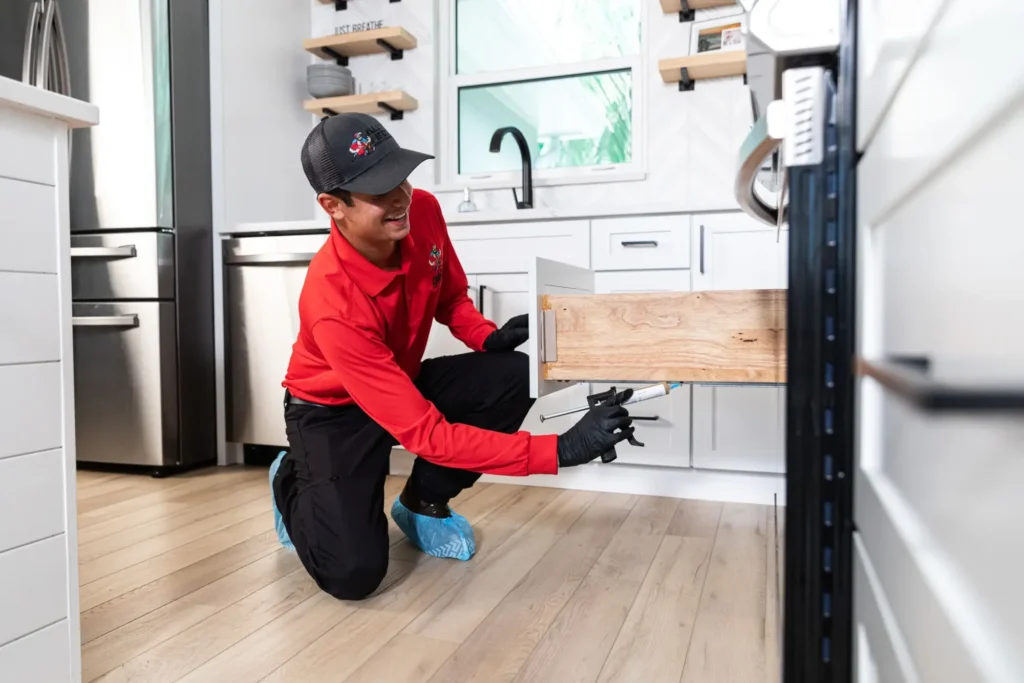
Cockroach Treatment in Cape Canaveral, FL
When it comes to treating a cockroach infestation in Cape Canaveral, it’s essential to tailor your approach to our unique local conditions. Here’s a step-by-step guide to effectively treating your home:
- Inspection Start with a thorough inspection of your property. In Cape Canaveral, pay special attention to areas near the foundation, as our sandy soil can create easy access points for cockroaches.
- Identification Determine which species of cockroach you’re dealing with. In Cape Canaveral, you’re likely to encounter American, German, or Florida Woods cockroaches, each requiring slightly different treatment approaches.
- Sanitation Clean your home thoroughly, paying extra attention to the kitchen and bathroom. In our warm climate, even small amounts of food or moisture can sustain a cockroach population.
- Moisture control Address any sources of excess moisture in and around your home. This might include fixing leaky pipes, improving ventilation, or addressing drainage issues in your yard.
- Exclusion Seal potential entry points. In Cape Canaveral homes, this often includes sealing gaps around pipes, fixing damaged window screens, and installing door sweeps.
- Baiting Place bait stations in strategic locations throughout your home. In our climate, you’ll want to focus on warm, humid areas where cockroaches are likely to congregate.
- Insecticide application If necessary, apply insecticides to create a barrier against cockroaches. Focus on baseboards, under appliances, and around entry points.
- Outdoor treatment Don’t forget to treat the exterior of your home. In Cape Canaveral, cockroaches often live outdoors and enter homes seeking food or shelter.
- Follow-up Monitor the situation closely and be prepared to repeat treatments if necessary. In our climate, it may take several rounds of treatment to fully eliminate an infestation.
Remember, persistence is key when treating cockroaches in Cape Canaveral. Our warm, humid climate can support large cockroach populations, so be prepared for an ongoing battle.
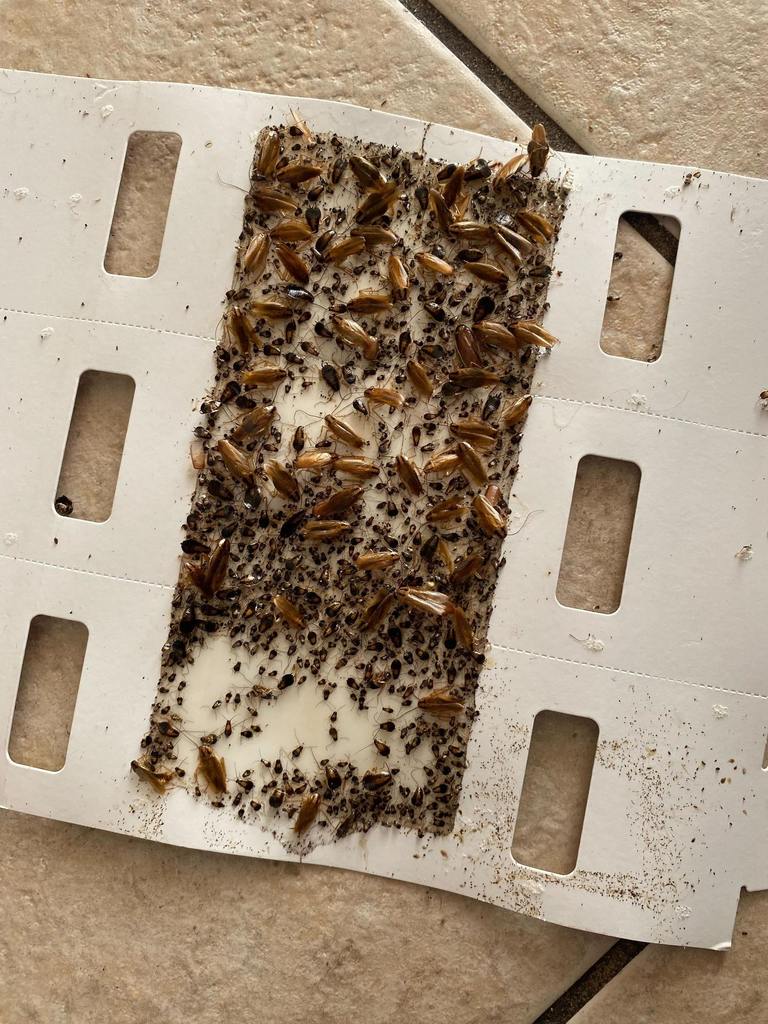
Signs of a Cockroach Infestation in Cape Canaveral, FL
Recognizing the signs of a cockroach infestation early can help you address the problem before it gets out of hand. In Cape Canaveral, where our climate supports year-round cockroach activity, it’s especially important to stay vigilant. Here are some signs to watch out for:
- Live cockroaches The most obvious sign is seeing live cockroaches, especially during the day. In Cape Canaveral, you might spot them scurrying for cover when you turn on lights in a dark room.
- Cockroach droppings Look for small, dark droppings that resemble coffee grounds or black pepper. In our humid climate, these droppings can accumulate quickly in hidden areas.
- Egg cases Cockroach egg cases, or oothecae, are small, brown, and oval-shaped. In Cape Canaveral homes, you might find these in warm, humid areas like under the sink or behind the refrigerator.
- Musty odor A strong, musty smell can indicate a large cockroach infestation. This odor is particularly noticeable in enclosed spaces like cabinets or pantries.
- Smear marks Cockroaches leave behind dark, irregular smear marks on surfaces they frequently travel. In Cape Canaveral homes, these are often found along baseboards or in corners.
- Cast skins As cockroaches grow, they shed their exoskeletons. Finding these light brown, empty shells is a clear sign of an active infestation.
- Damage to food packaging Look for small holes or tears in food packaging, especially in items stored in pantries or cabinets.
- Unexplained stains Cockroaches can leave behind dark, irregular stains on surfaces, particularly in areas where they congregate.
If you notice any of these signs in your Cape Canaveral home, it’s time to take action. Remember, in our warm climate, cockroach populations can grow quickly if left unchecked.
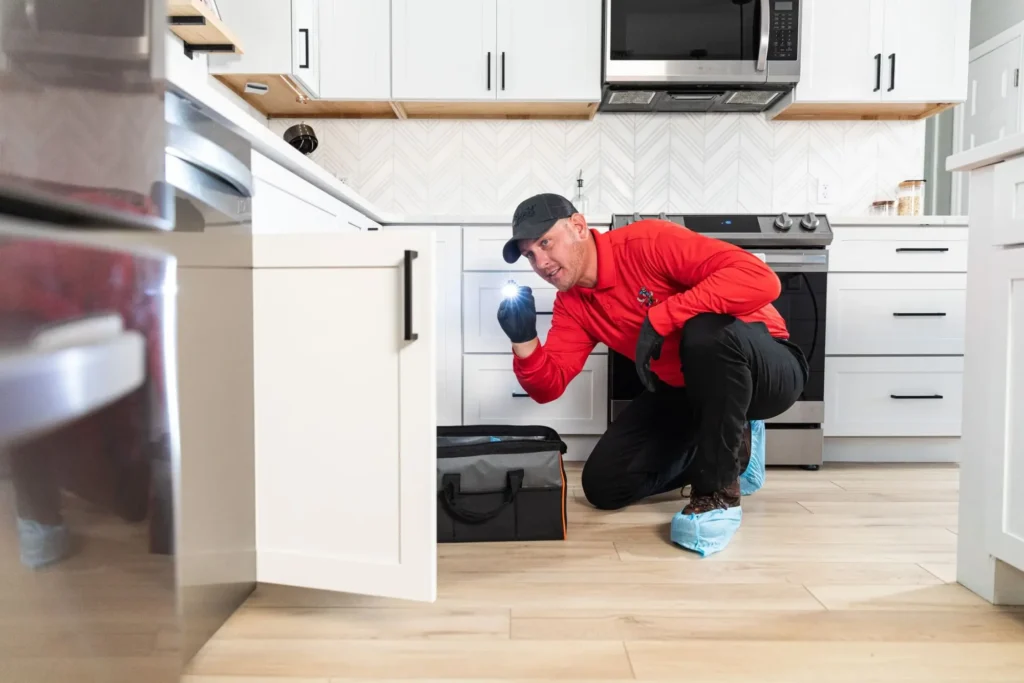
How to Check Your Cape Canaveral Home for Cockroaches
Regular inspections are crucial for early detection and prevention of cockroach infestations in Cape Canaveral. Here’s how you can thoroughly check your home:
- Kitchen inspection Start in the kitchen, as it’s a prime location for cockroaches in any home. Check under and behind appliances, inside cabinets, and along baseboards. In Cape Canaveral’s humid climate, pay extra attention to areas near the sink and dishwasher.
- Bathroom check Bathrooms are another hotspot due to the moisture. Inspect under sinks,around toilets, and in any cracks or crevices. Don’t forget to check behind mirrors and in medicine cabinets.
- Utility areas Examine areas around water heaters, washing machines, and dryers. These appliances create warmth and moisture that cockroaches love, especially in our climate.
- Closets and storage areas Go through closets, paying attention to dark corners and areas where items are stored long-term. In Cape Canaveral, cockroaches often seek shelter in these undisturbed areas.
- Exterior inspection Don’t neglect the outside of your home. Check around the foundation, in mulch beds, and near outdoor water sources. In our coastal environment, outdoor cockroach populations can quickly move indoors.
- Attic and crawl spaces If accessible, inspect these areas. In Cape Canaveral’s warm climate, these spaces can provide ideal conditions for cockroaches to thrive.
- Night inspection Conduct a nighttime inspection with a flashlight. Cockroaches are nocturnal, so you’re more likely to catch them active after dark.
- Use sticky traps Place sticky traps in suspected problem areas and check them regularly. This can help you identify cockroach travel routes in your home.
- Check for moisture issues Given Cape Canaveral’s humid climate, pay special attention to any areas with excess moisture or poor ventilation.
- Inspect recent deliveries Cockroaches can hitch a ride on packages or groceries. Carefully inspect items before bringing them into your home.
Remember, thoroughness is key when checking for cockroaches. In Cape Canaveral’s climate, even a small oversight can lead to a full-blown infestation if left unchecked.

What Do Cockroaches Look Like in Cape Canaveral, FL?
In Cape Canaveral, you’re likely to encounter several species of cockroaches. Knowing what to look for can help you identify and address infestations more effectively. Here’s a guide to the most common cockroach species in our area:
Smoky Brown Cockroach
Smoky brown cockroaches are prevalent in Cape Canaveral due to our warm, humid climate. These cockroaches are large, typically measuring 1.25 to 1.5 inches long, with a uniformly dark brown or mahogany color. They have fully developed wings and are capable of flight. In Cape Canaveral, you’re likely to spot smoky brown cockroaches around your home’s exterior, especially in mulch beds or near outdoor lighting. They’re attracted to moisture, so areas near sprinkler systems or air conditioning units are common habitats.
American Cockroach
The American cockroach, also known as the palmetto bug, is one of the largest cockroach species you’ll encounter in Cape Canaveral. These cockroaches measure 1.5 to 2 inches long and have a reddish-brown color with a yellowish figure-eight pattern on the back of the head. They have wings and can glide short distances. American cockroaches are often found in damp areas like basements, sewers, and storm drains. In Cape Canaveral homes, they often enter through small cracks and crevices, especially during periods of heavy rain or extreme heat.
Australian Cockroach
Despite their name, Australian cockroaches are well-established in Cape Canaveral. They’re similar in appearance to American cockroaches but slightly smaller, typically 1 to 1.25 inches long. These cockroaches are dark brown with light yellow edges on the thorax and wings, and have a distinctive yellow streak on the outer edge of the forewing. They prefer warm, moist environments and are often found in greenhouses or near houseplants. In Cape Canaveral, you might find Australian cockroaches in your garden or entering your home through small openings, especially during dry spells when they’re seeking moisture.
German Cockroach
German cockroaches are the most common indoor cockroach species in Cape Canaveral. They’re smaller than the other species mentioned, measuring 0.5 to 0.6 inches long, with a light brown to tan color and two dark parallel stripes running from head to wing tips. Although they have wings, they rarely fly. German cockroaches are often found in kitchens and bathrooms, near food and water sources. In Cape Canaveral homes, they can be particularly problematic due to our year-round warm temperatures, which support continuous breeding cycles.
Florida Woods Cockroach
The Florida Woods cockroach, also known as the palmetto bug, is native to our area and well-adapted to Cape Canaveral’s climate. These cockroaches are large, typically 1.25 to 1.5 inches long, with a dark brown to black color. They have wings but are poor fliers. Florida Woods cockroaches prefer outdoor environments but may enter homes during extreme weather. In Cape Canaveral, you’re likely to encounter them in your yard, especially in areas with dense vegetation or piles of leaves and wood. They may enter homes seeking shelter during heavy rains or cold snaps, which are rare but do occur in our area.
Understanding the appearance and habits of these different cockroach species can help you identify infestations early and choose the most effective control methods for your Cape Canaveral home.
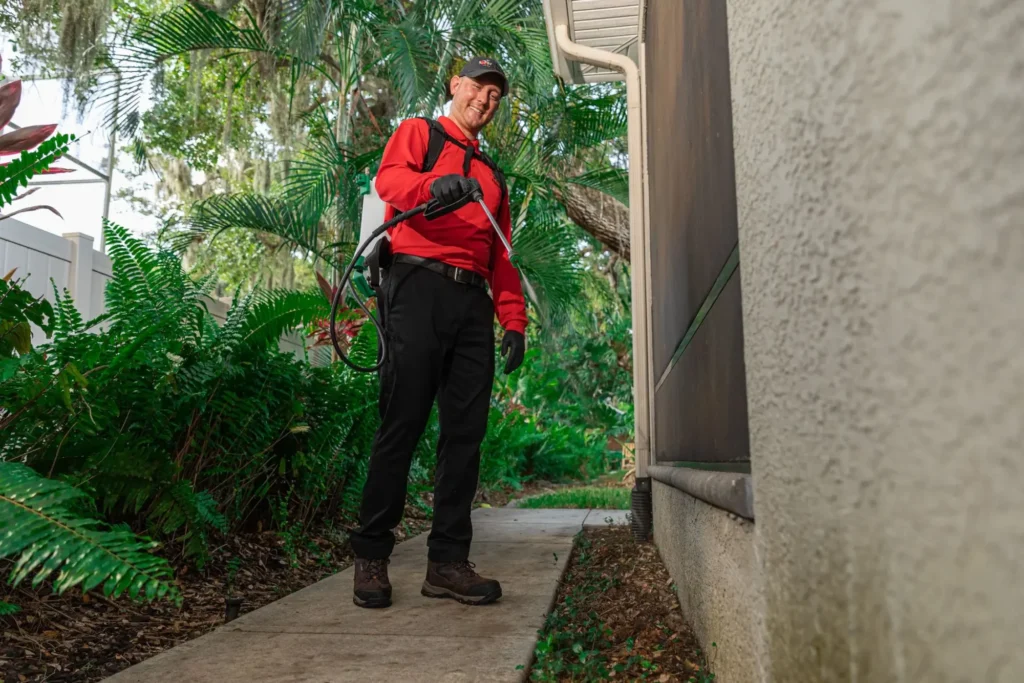
Eco-friendly Solutions for Cockroach Control
In Cape Canaveral, where we’re surrounded by sensitive coastal ecosystems, it’s important to consider eco-friendly solutions for cockroach control. These methods can be effective while minimizing harm to the environment:
- Diatomaceous Earth This natural substance is made from fossilized algae and works by dehydrating cockroaches. Sprinkle it in areas where you’ve seen cockroach activity. In Cape Canaveral’s humid climate, you may need to reapply more frequently than in drier areas.
- Boric Acid Another natural option, boric acid is toxic to cockroaches but low in toxicity for humans and pets. Apply it in thin layers in areas where cockroaches travel. Be cautious in using this near the beach, as it can be harmful to marine life if it washes into the ocean.
- Sticky Traps While not a solution on their own, sticky traps can help you monitor cockroach activity and catch some of the pests. Place them along baseboards and in corners.
- Natural Predators Encourage natural cockroach predators in your yard, such as birds and lizards. Creating a diverse garden can help keep outdoor cockroach populations in check.
- Neem Oil This natural insecticide can be effective against cockroaches. Mix it with water and spray in areas where you’ve seen cockroach activity.
- Cucumber Slices Believe it or not, cockroaches dislike the smell of cucumbers. Placing cucumber slices in problem areas can help deter them.
- Catnip Studies have shown that catnip can be an effective cockroach repellent. Grow it in your garden or place sachets of dried catnip in problem areas.
- Bay Leaves The strong smell of bay leaves can deter cockroaches. Place whole bay leaves in cabinets and other areas where you’ve seen cockroach activity.
- Proper Waste Management In Cape Canaveral’s warm climate, it’s crucial to manage waste properly. Use sealed compost bins and ensure trash cans have tight-fitting lids.
Remember, while these eco-friendly solutions can be effective, severe infestations may require more intensive treatments. Always consider the unique aspects of your Cape Canaveral home and surroundings when choosing a cockroach control method.

Preventing Cockroaches in Cape Canaveral, FL
Prevention is key when it comes to cockroach control in Cape Canaveral. Our warm, humid climate provides ideal conditions for cockroaches year-round, so it’s important to be proactive. Here are some strategies to help keep your Cape Canaveral home cockroach-free:
- Seal Entry Points Inspect the exterior of your home for cracks and crevices, paying special attention to areas where pipes and wires enter. Use caulk or weatherstripping to seal these potential entry points. In Cape Canaveral’s sandy soil, cockroaches can easily burrow near foundations, so be thorough in your inspection.
- Manage Moisture Our humid climate means moisture control is crucial. Fix any leaky pipes promptly, use dehumidifiers in damp areas, and ensure proper ventilation in bathrooms and kitchens. Consider using moisture-resistant materials in areas prone to dampness.
- Proper Food Storage Store food in airtight containers and clean up spills immediately. In our warm climate, even small amounts of food can quickly attract cockroaches. Don’t forget about pet food – store it in sealed containers and don’t leave it out overnight.
- Regular Cleaning Maintain a consistent cleaning routine, paying special attention to kitchens and bathrooms. Vacuum regularly, including under and behind appliances. In Cape Canaveral, where we often track in sand from the beach, be sure to sweep or vacuum entryways frequently.
- Declutter Reduce clutter, especially cardboard boxes and piles of newspapers, which can provide hiding spots for cockroaches. In our climate, consider using plastic storage containers instead of cardboard.
- Yard Maintenance Keep your yard tidy by removing leaf litter, trimming bushes away from your home’s exterior, and storing firewood away from the house. In Cape Canaveral, pay special attention to palm trees, as cockroaches often hide in the fronds.
- Proper Waste Management Use trash cans with tight-fitting lids and take out the garbage regularly. In our warm climate, organic waste can decompose quickly, attracting pests.
- Inspect Incoming Items Before bringing groceries, packages, or secondhand itemsinto your home, inspect them for signs of cockroaches. This is especially important in Cape Canaveral, where our busy port means items come in from all over the world.
- Use Natural Repellents Plant mint or bay leaves around your home’s exterior. These plants can help repel cockroaches and thrive in Cape Canaveral’s climate.
- Regular Inspections Conduct regular inspections of your home, paying special attention to dark, warm, and moist areas. Early detection can prevent a small problem from becoming a full-blown infestation.
- Address Standing Water Eliminate sources of standing water in your yard, such as in plant saucers or clogged gutters. In Cape Canaveral’s rainy season, this can be an ongoing task.
- Use Weatherstripping Install weatherstripping on doors and windows to create a tighter seal. This is particularly important in older Cape Canaveral homes that may have settled over time.
- Consider Professional Prevention Schedule regular preventive treatments with a pest control professional. They can apply treatments that create a barrier against cockroaches and other pests.
By implementing these prevention strategies, you can significantly reduce the likelihood of a cockroach infestation in your Cape Canaveral home. Remember, consistency is key – make these practices part of your regular home maintenance routine.
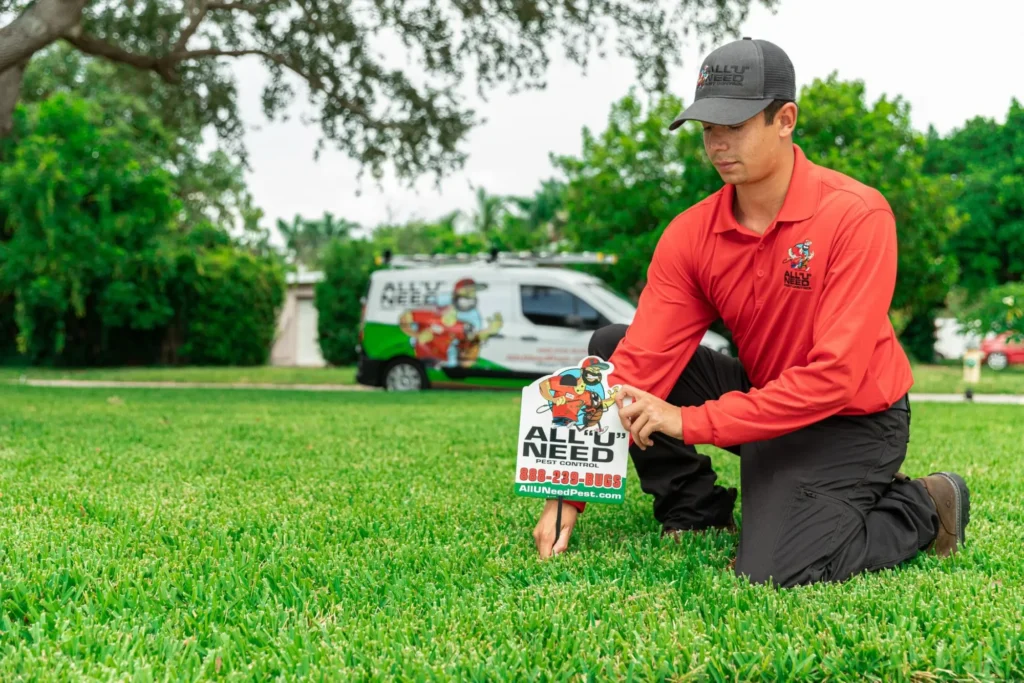
Exterminate Cockroaches From Your Cape Canaveral Home with All U Need Pest Control
Living in beautiful Cape Canaveral doesn’t mean you have to share your space with cockroaches. While our warm, coastal climate can make cockroach control challenging, it’s far from impossible. With the right knowledge and tools, you can keep your home cockroach-free and enjoy all that our Space Coast paradise has to offer.
Remember, whether you’re dealing with American cockroaches in your garage, German cockroaches in your kitchen, or Florida Woods cockroaches in your yard, each species requires a tailored approach. By understanding their habits and implementing the prevention strategies we’ve discussed, you can create an environment that’s inhospitable to these persistent pests.
However, if you find yourself facing a stubborn infestation or simply want the peace of mind that comes with professional service, don’t hesitate to call in the experts. All U Need Pest Control understands the unique challenges of cockroach control in Cape Canaveral. Our team is equipped with the knowledge, experience, and tools to effectively eliminate cockroach infestations while respecting our local environment.
From eco-friendly solutions to targeted treatments, we offer a range of services tailored to your specific needs. We’re committed to not just eliminating current infestations, but also to preventing future problems, ensuring your Cape Canaveral home remains a cockroach-free zone.
Don’t let cockroaches launch an invasion of your space. Take control today and enjoy a pest-free home in our beautiful coastal city. Contact All U Need Pest Control for a consultation and let us help you achieve lasting cockroach control in your Cape Canaveral home. Your comfort and peace of mind are our top priority!
Location Contact:
310 N Wickham Road Unit 117 Melbourne, FL 32935
Get Directions for 310 N Wickham Road Unit 117Melbourne, FL 32935 on Google Maps321-351-0573
Call All "U" Need Pest Control